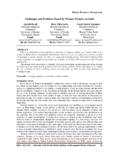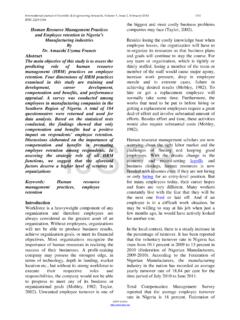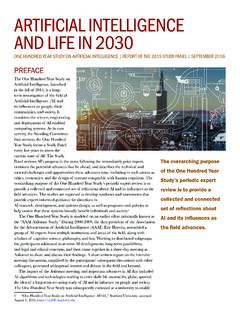Transcription of The Impact of Employee Engagement Factors and Job ...
1 The Impact of Employee Engagement Factors and Job Satisfaction On Turnover Intent Mary Lynn Berry and Michael L. Morris The University of Tennessee, Knoxville The current literature review examined a proposed relationship between the antecedent -- Employee Engagement Factors and the outcome variable turnover intent mediated by job satisfaction. Kahn s Personal Engagement Theory, Equity Theory, and Herzberg s Two-Factor Theory of Job Satisfaction were used as the theoretical underpinnings for the review. Implications for human resource development were discussed. Keywords: Employee Engagement , Job Satisfaction, Turnover Intent The challenge today is not just retaining talented people, but fully engaging them, capturing their minds and hearts at each stage of their work lives (Lockwood, 2007, ) While healthy turnover in an organization can be positive, refreshing, and helpful in introducing new ideas and techniques that can move the organization to greater levels of success, turnover among highly-productive, key employees is costly (Hellman, 1997).
2 According to a number of researchers, typical turnover costs include exit costs ( , administrative time and pay for leave not taken), temporary replacement costs ( , agency fees and training); recruitment and selection costs ( , advertising costs, agency fees, lost time); decreased morale and productivity among retained workers; loss of future key talent ( , intellectual capital including knowledge, skills, and experience); and sharing of organizational processes, technology , and relationships ( , Fitz-enz, 2001; International Survey Research). Since, the long-term retention of a highly productive workforce is coveted, and a goal of human resources is to attract and maintain highly productive employees, it is imperative for human resources to better understand how to maximize the retention of productive employees.
3 Despite the fact that retention of highly-productive, key employees is certainly an important task for human resources, so is the creation and development of a workplace that not only encourages retention, but also high levels of productivity among all employees. Many researchers (Buckingham & Coffman, 1999; Seijts & Crim, 2006; Harter, Schmidt, & Hayes, 2002) have used the term Engagement to refer to employees who are involved in, enthusiastic about, and satisfied with his or her work. The Towers Perrin Talent Report (2003) found that approximately 81% of employees surveyed were engaged, but as many as 19% of employees surveyed were disengaged.
4 Disengaged employees are more likely to perform poorly, actively look for another job, and say bad things about management or the organization for which they work (Gubman, 2004). Such counterproductive work behavior also has a documented relationship with a lack of organizational citizenship (Dalal, 2005). Sanford (2003) reported that disengaged employees cost their businesses financially via decreased profits, decreased sales, lower customer satisfaction, and lower productivity; furthermore, Sanford reported that Gallup estimated that actively disengaged employees may cost the American economy up to $350 billion per year in lost productivity.
5 HRD can encourage Employee Engagement in the workplace by emphasizing high Impact learning, performance and change. Encouraging Employee Engagement through these avenues has enormous return on investment (ROI) potential for organizations. Problem Statement The concept of Employee Engagement has appeared fairly recently in the literature. Because of its relative infancy, there is a lack of information about the relationship between known Employee Engagement Factors (Buckingham et al., 1999), job satisfaction, and turnover intent. Not only is there a lack of information, there are discrepancies between studies that cloud our understanding of the relationships of the aforementioned variables.
6 Because of this lack of information, there exist missed opportunities for growth, development, and change that could essentially affect the performance of an organization. Copyright 2008 Mary Lynn Berry & Michael L. Morris 1-3 Nominal Definitions The following key terms are important to this paper and are defined below. Employee Engagement Employee Engagement is the act of an Employee being involved in, enthusiastic about, and satisfied with his or her work (Seijts et al., 2006; Harter et al., 2002; articles/ ; Gubman, 2004). Employee Engagement Factors Employee Engagement Factors include the characteristics of a workplace that attract and retain the most productive employees (Buckingham et al.)
7 , 1999, p. 30). Job Satisfaction Job Satisfaction refers to the contentment an individual has with her or her job. Employee Retention Employee retention (versus Employee turnover) refers to the continued employment of employees. Optimally, high-quality, productive employees are retained. Employee Turnover Employee turnover (versus Employee retention) refers to the process of an Employee leaving a position and a new Employee hired to take his or her place. Employee turnover can be voluntary and involuntary as well as internal and external. Of particular concern to the current study is Employee turnover that is both voluntary and external in nature.
8 Turnover Intent Turnover intent refers to the voluntary intention of an Employee to leave an organization. Purpose of the Study The purpose of the study was to examine the hypothesized relationship between the selected work-related predictor variable ( Employee Engagement Factors ) on the outcome variable (turnover intent) through the mediator variable, job satisfaction (see hypothesized model in Figure 1). When the influences of Employee Engagement Factors on turnover intent through job satisfaction are ascertained, improvements can be made in the work environment that lead to increased organizational performance. This article explores the Employee Engagement -job satisfaction-turnover intent relationship.
9 An overview of the literature is provided from selected HRD-related journals. This article will be presented as follows: a) theoretical framework, b) literature review, and c) research questions and suggested instrumentation, d) contributions to new knowledge in HRD, and e) conclusion. Employee Engagement Factors Job Satisfaction --+Turnover Intent Figure 1. Proposed Model Detailing the Relationships between Employee Engagement Factors , Job Satisfaction, and Intent to Leave. Theoretical Framework For HRD professionals, there are a multitude of psychological, economic, and systems theories that may serve as underpinnings for the current literature review.
10 However, for the current study only three Personal Engagement Theory (Kahn, 1990), Herzberg s Two Factor Theory of Job Satisfaction (2003), and Equity Theory (Cook & Parcel, 1975) were particularly useful in explaining the relationships of interest. Kahn s personal Engagement theoretical framework was helpful in better understanding the concept of Employee Engagement . According to Kahn s (1990) personal Engagement theoretical framework, people express themselves physically, cognitively, and emotionally in the roles they occupy; people are more excited and content with their roles when they draw on themselves to perform their roles; and people vary in their levels of attachment to 1-3their roles.



















